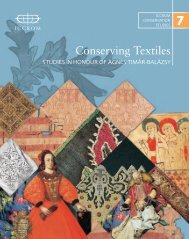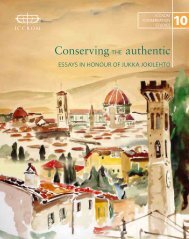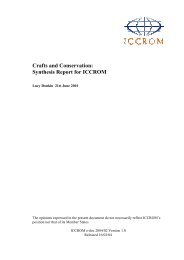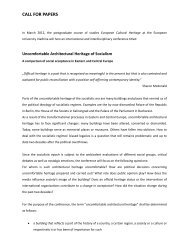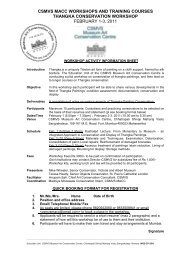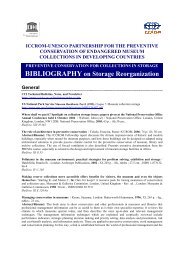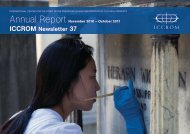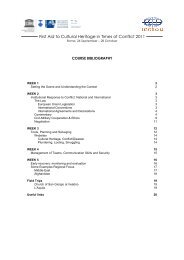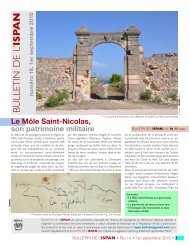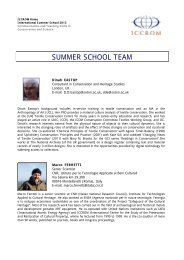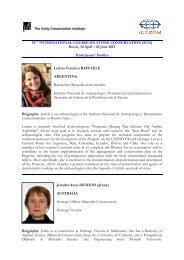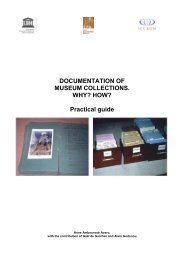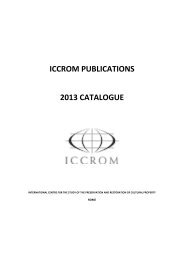part 1 - Iccrom
part 1 - Iccrom
part 1 - Iccrom
Create successful ePaper yourself
Turn your PDF publications into a flip-book with our unique Google optimized e-Paper software.
MEASURING HERITAGE CONSERVATION PERFORMANCE<br />
6th International Seminar on Urban Conservation<br />
6.1. Social capital, sense of community<br />
and sense of cultural identity<br />
As mentioned above, one aspect that is frequently<br />
mentioned in conservation heritage projects is social<br />
capital, which is defined as the degree of connectedness<br />
between individuals or groups, which give<br />
them a variety of benefits and the ability to become<br />
more productive (Paxton, 1999, p. 90). Social capital<br />
depends mainly on the trust that individuals have<br />
on each other, as well as on the association capacity<br />
of groups. Both trust and association capacity have<br />
been measured by structured interviews with scoring<br />
systems, in which individuals are asked questions<br />
about their social life and the trust they have in<br />
people (Paxton, 1999, pp. 105-107).<br />
The sense of community is also a very frequent<br />
aspect cited in conservation and heritage literature,<br />
which is described as a very powerful and positive<br />
feeling from individuals belonging to a <strong>part</strong>icular<br />
social group that can be enhanced through the valorization<br />
and enjoyment of cultural heritage. Sense<br />
of community has a dramatic effect on people’s attitudes<br />
and actions, since it positively affects their perception<br />
of social relations and their own control and<br />
empowerment. Sense of community has also been<br />
assessed through structured interviews with questions<br />
about how people feel about their communities<br />
(Chavis and Wandersman, 1990).<br />
Sense of community is closely related to sense of<br />
cultural identity. The latter is a type of collective<br />
identity, by which individuals feel, in a self-ascribed<br />
way, connected to other individuals who share some<br />
cultural characteristics (Ashmore et al., 2004, p. 81).<br />
Cultural identity is based on a common cultural heritage<br />
that may appeal to ethnic, religious or national<br />
values and aspirations. However, we know that<br />
heritage and cultural identity may also be a source<br />
of conflict when tolerance and cultural diversity<br />
are not promoted. For this reason any assessment<br />
should also consider the negative social consequences<br />
that conservation and the revalorization<br />
of cultural heritage may bring about. The sense of<br />
cultural identity is generally assessed through questions<br />
of self-understanding and self-ascription. It<br />
has also been assessed through the use of discourse<br />
analysis and content analysis. Discourse analysis is<br />
the qualitative interpretative analysis of meaning<br />
that is applied to texts, speeches, and social practices<br />
in which social actors express themselves (Abdelal<br />
et al., 2005, p. 14), which requires deep social knowledge<br />
and interpretative skills, as well as familiarity<br />
with the cultural discourse. Content analysis is a<br />
quantitative assessment of specific meaning codes<br />
that are present in texts or speeches (Abdelal et al.,<br />
2005, p. 17).<br />
The sense of place is also a potential social benefit<br />
obtained with the conservation of cultural heritage.<br />
In this respect, English Heritage (2009, p. 13) states<br />
that the revalorization of the historic environment<br />
has a clear positive impact on the sense of place<br />
that people have, which in turn can impact on crime<br />
levels, social inclusion and regeneration. Individuals<br />
with stronger sense of place, therefore, engage<br />
with their communities in a more active way and<br />
therefore build on social capital. English Heritage’s<br />
approach is underpinned by the notion of ‘sustainable<br />
communities’, which aims, among other things,<br />
at developing the local economy, encouraging <strong>part</strong>icipation<br />
of community members and fostering a<br />
diverse creative culture with a strong sense of place<br />
(English Heritage, 2005, p. 10).<br />
6.2. Positive social impacts: some examples<br />
Some concrete experiences of conservation and heritage<br />
projects have shown positive social impacts,<br />
albeit without standardized social indicators to<br />
demonstrate this success.<br />
In the case of Incallajta, an important archaeological<br />
site in Bolivia, involvement of the local community<br />
in the excavation and management of the site<br />
resulted in the revalorization of the archaeological<br />
remains, which propitiated a harmonic and sustainable<br />
development of the community based on the<br />
strengthening of social bonds (Muñoz Collazos,<br />
2007).<br />
A similar approach has been taken on projects by<br />
conservators from the Coordinación Nacional de Conservación<br />
del Patrimonio Cultural (CNCPC) of Mexico.<br />
These projects have a community-based approach<br />
that emphasize the active <strong>part</strong>icipation of members<br />
from rural or small-scale communities, and in<br />
fact conservators only intervene when communities<br />
have asked for professional assistance (Magar,<br />
2005; Noval Vilar, 2010). This group of conservators<br />
consider the members of communities as the legitimate<br />
owners of this heritage (Noval Vilar, 2009),<br />
in contrast to national discourse and legislation<br />
that emphasizes national ownership (Diario Oficial<br />
de la Federación, 1972). After conservators have<br />
been called by the communities, the first stage is to<br />
organize ‘reflection workshops’ where the values<br />
of heritage are discussed and outlined that dictate<br />
the conservation processes. These projects aim at<br />
developing a sense of common ownership of their<br />
Alonso, V. I. & V. M. Meurs. 2012. Assessing the performance of conservation activities. In Zancheti, S. M. & K. Similä, eds. Measuring<br />
heritage conservation performance, pp. 1-14. Rome, ICCROM.<br />
8



